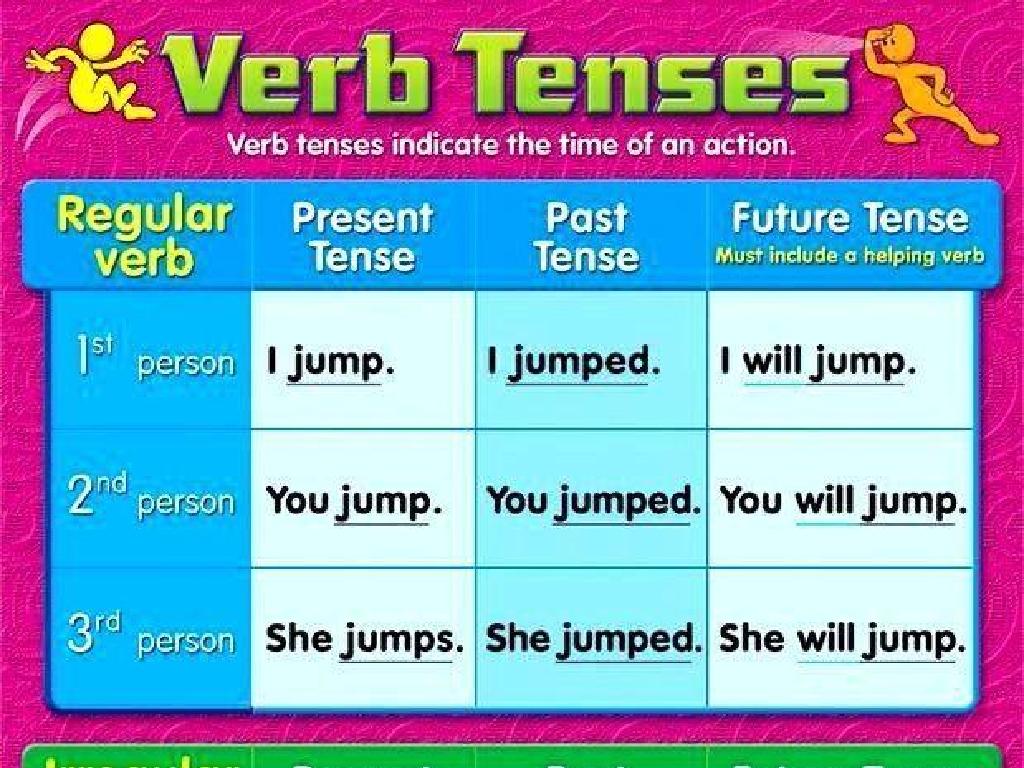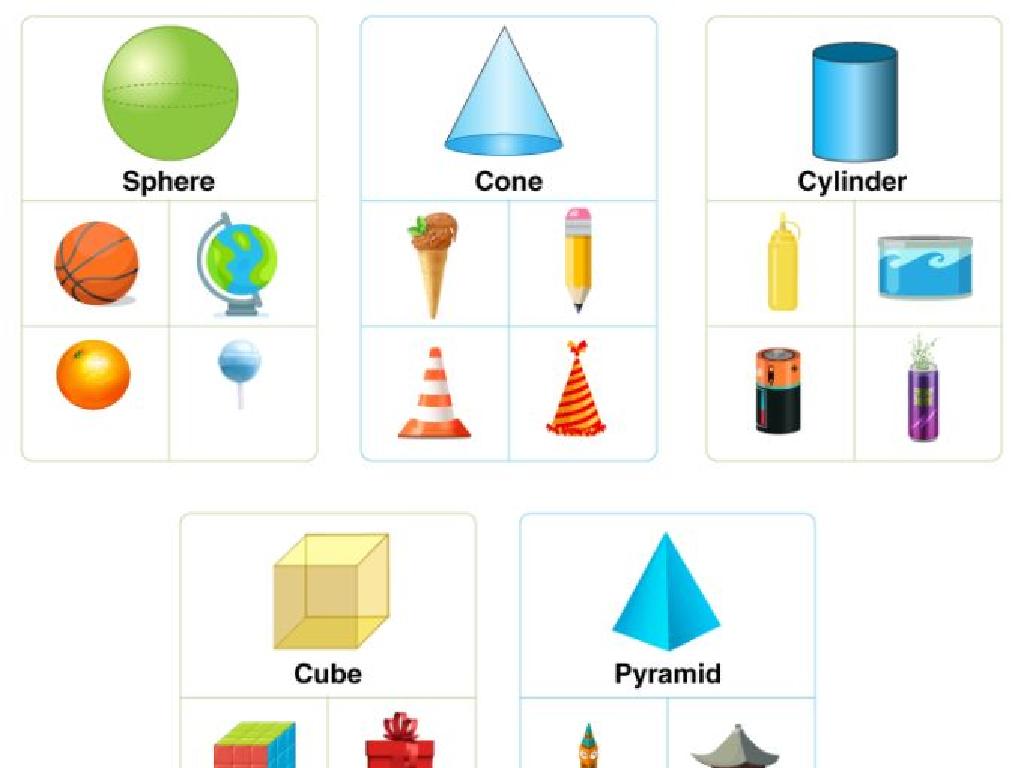Probability Of One Event
Subject: Math
Grade: Sixth grade
Topic: Probability
Please LOG IN to download the presentation. Access is available to registered users only.
View More Content
Welcome to Probability!
– Understanding chance in probability
– Chance measures the likelihood of an event happening
– Defining probability
– Probability is the chance of a specific outcome
– Probability in daily life
– Coin tosses, weather forecasting, and board games
– Calculating simple probability
– Use the formula: Probability = Number of favorable outcomes / Total possible outcomes
|
This slide introduces the concept of probability as a measure of chance, explaining how likely an event is to occur. Start by discussing everyday situations where probability is used, such as predicting the weather or the outcome of a game. Define probability as a numerical measure between 0 and 1, where 0 means an event will not occur, and 1 means it will definitely occur. Provide simple examples like the probability of getting heads in a coin toss (1/2) to illustrate how to calculate probability. Encourage students to think of other real-life examples and to understand that probability is all around us, helping us make informed decisions based on the likelihood of different outcomes.
Understanding Probability
– Probability: likelihood of an event
– It predicts how likely something will happen
– Expressed as a number: 0 to 1
– 0 means it will not happen, 1 means it will definitely happen
– Probability 0: an impossible event
– Probability 1: a certain event
|
This slide introduces the concept of probability to the students, explaining that it is a measure of how likely an event is to occur. Probability is quantified as a number between 0 and 1, where 0 indicates impossibility and 1 indicates certainty. To help students grasp these concepts, provide examples such as the probability of flipping a coin and getting heads (0.5) or the probability of drawing a red card from a standard deck (0.5). Emphasize that probability is a way to predict the chance of various outcomes and is a fundamental concept in mathematics that applies to many real-world situations.
Understanding Types of Events in Probability
– Simple Event: a single outcome
– A simple event has only one possible result, like heads or tails.
– Example: flipping a coin
– When you flip a coin, it can only land on heads or tails, not both.
– Compound Event: multiple simple events
– Compound events involve combinations of two or more outcomes.
– Example: rolling two dice
– Rolling two dice can result in various pairs of numbers (1,1), (1,2), etc.
|
This slide introduces students to the foundational concepts of probability, focusing on the difference between simple and compound events. A simple event has only one possible outcome, which makes it easier to calculate its probability. For example, flipping a coin has two possible outcomes, heads or tails. A compound event, on the other hand, involves multiple simple events occurring together, such as rolling two dice, where each die is a simple event but combined they form a compound event with more possible outcomes. Understanding these concepts is crucial for students to grasp the basics of probability and how it applies to different scenarios.
Calculating Probability of an Event
– Probability formula
– Probability = Favorable outcomes / Total outcomes
– Favorable vs. possible outcomes
– Favorable: outcomes we want; Possible: all outcomes
– Example: Rolling a die
– What’s the chance of getting a 4 on a 6-sided die?
– Simplifying probability expressions
– Reduce fractions to simplest form for final probability
|
This slide introduces the fundamental concept of calculating the probability of a single event. The probability formula is a ratio of the number of favorable outcomes to the total number of possible outcomes. It’s crucial for students to differentiate between favorable outcomes (what we’re looking for) and possible outcomes (all that could happen). For example, when rolling a standard 6-sided die, there is only one way to roll a 4, making it the favorable outcome, while there are six possible outcomes (1 through 6). Therefore, the probability of rolling a 4 is 1/6. Encourage students to practice by calculating probabilities for different scenarios and simplifying their answers.
Exploring Probability with Simple Events
– Probability of heads in a coin flip
– 50% chance, as a coin has 2 sides: heads or tails
– Rolling a die for a six
– 1 in 6 chance, since a die has 6 faces
– Drawing an Ace from a deck
– 1 in 13 chance, as there are 4 Aces in a 52-card deck
|
This slide introduces students to the concept of probability through familiar examples. Begin by explaining that probability measures how likely an event is to occur. Use a coin flip to illustrate a simple event with two possible outcomes, making the probability 1/2 or 50%. Move on to a six-sided die, where each face has an equal chance of landing face up, so the probability of rolling a six is 1/6. Lastly, discuss a standard deck of cards, which contains 52 cards with 4 Aces, giving a probability of drawing an Ace as 1/13. Encourage students to think about probability as part of everyday decision-making and to come up with their own examples of events with different probabilities.
Probability Practice: Coins, Dice, & Cards
– Solve probability problems
– Use coins for practice
– Heads or tails? What’s the probability?
– Use dice for practice
– Rolling a six: what are the chances?
– Use cards for practice
– Drawing an ace from a deck, let’s calculate!
|
This slide is aimed at providing students with hands-on practice in calculating the probability of single events using familiar items such as coins, dice, and playing cards. For coins, they will explore the 50/50 chance of getting heads or tails. With dice, they will calculate the probability of rolling a specific number, such as a six, which has a 1 in 6 chance. For cards, they will determine the likelihood of drawing an ace out of a standard deck of 52 cards. Encourage students to think about the total number of possible outcomes and the number of favorable outcomes for each scenario. This practical application helps solidify their understanding of probability concepts.
Class Activity: Coin Flip Probability
– Perform a coin flip experiment
– Each student flips a coin 50 times
– Record each flip’s outcome
– Tally the number of heads and tails
– Calculate probability of heads
– Use formula: Probability = (Number of heads) / (Total flips)
|
This activity is designed to give students hands-on experience with probability. Each student will flip a coin 50 times, which will help them understand the concept of experimental probability versus theoretical probability. After recording their results, students will calculate the experimental probability of the coin landing on heads. Teachers should guide students through the process of setting up a tally chart for their results and using the formula to calculate probability. Possible variations for different students could include using different types of coins, flipping the coins more or fewer times, or working in pairs to combine data. This will help students see that as the number of flips increases, the experimental probability tends to get closer to the theoretical probability of 1/2.
Wrapping Up: Probability & Homework
– Recap of Probability concepts
– Homework: Probability worksheet
Complete the provided worksheet to reinforce today’s lesson.
– Study for upcoming Probability quiz
Review all notes and exercises to prepare for the quiz.
– Keep practicing with real-life examples
Try to apply probability to daily scenarios for better understanding.
|
This slide aims to summarize the key points of the Probability lesson and to set clear expectations for homework and assessment. The homework assignment involves completing a worksheet that will help students solidify their understanding of the concepts discussed in class. Additionally, students are advised to review their notes and practice problems to prepare for a quiz in the next class. Encourage students to think of probability in terms of everyday decisions and games to make the concept more relatable and engaging. Provide examples such as the likelihood of rain, chances of winning a game, or picking a certain colored marble from a bag.





